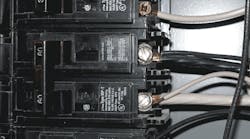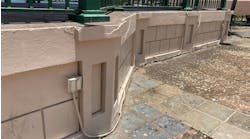How well do you know the Code? Think you can spot violations the original installer either ignored or couldn't identify? Here's your chance to moonlight as an electrical inspector and second-guess someone else's work from the safety of your living room or office. Brian, who has a knack for finding shoddy electrical work, did the dirty work and found this mess. Now it's your turn to identify the violation.
Find the Answer
this particular installation, you can plainly see two conductors that have "white" insulation being used as phase conductors. This is a clear violation of 200.7, which limits the use of the color white "only to grounded circuit conductors, unless otherwise permitted in 200.7(B) or (C)."
Given that these conductors are operating at 120VAC, the rule of 200.7(B), which covers systems operating at less than 50V does not apply. And while there is limited permission for a conductor other than the grounded conductor to be colored "white," re-identification of the white insulated conductor is required. As noted in 200.7(C)(1), "If part of a cable assembly and where re-identified to indicate its use as an ungrounded conductor, by painting or other effective means at its termination, and at each location where the conductor is visible and accessible." This re-identification must completely encircle the conductor and be "a color other than white, gray, or green." Otherwise, such use of a white-colored conductor is a clear violation of the Code.
Another potential violation is the termination of two conductors under a single terminal. Such application is a violation of 110.3(B), which mandates all equipment to be used in accordance with any instructions given with the listing or labeling. This rule essentially and effectively makes all instructions given in the Underwriters Laboratories (UL) Directories — the so-called White Book, Green Book, Red Book, and Orange Book — part of the NEC. UL has long indicated in its general requirements that all listed terminating devices are suited for one conductor only, unless otherwise indicated. Although there is no way to know if this breaker's connection points are so listed without being able to fully identify the manufacturer and model number, my suspicion is it is not.
The last concern is related to the ampere rating of the breaker with two conductors terminated under a single terminal. These 12 AWG conductors are woefully under protected by the 60A breaker, even if this were a motor circuit.



